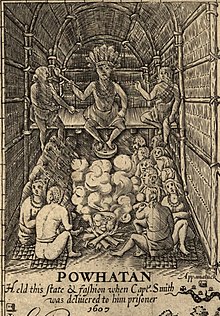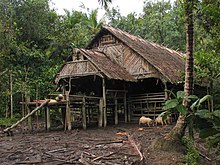Longhouse

A longhouse or long house is a type of building in several cultures. It is usually for many people living together.[1] Many buildings were made out of wood. Some used wood and stone. They were for long-term usage and not for people who moved around a lot. The longhouse was in Asia, Europe and North America. Native Americans built longhouses.
Europe[change | change source]
In Europe, they were in countries or regions like England, Germany and Scandinavia in the Middle Ages. The Dartmoor longhouse is an example from England. Old Frisian longhouse was form the Netherlands. Longhouses were common in northern regions of Germany. Vikings lived in longhouses. Longhouses were important during the Neolithic period and Bronze Age in Central Europe.[2]

Americas[change | change source]

The Iroquois tribes are known for living in large longhouses. Another name for Iroquois, Haudenosaunee means "People of the Longhouses". They lived in the Northeastern Woodlands. Bark was woven around poles. Wood was bent to make round-shaped roofs. There was usually a fireplace in the center and holes to let smoke out. Doors were covered with animal skin to keep people warm. Up to 20 families lived in these longhouses.[3]
The Iroquois Confederacy (Haudenosaunee) was made of the Seneca, Cayuga, Onondaga, Oneida and Mohawk tribes. Lenni Lenape and Powhatan tribes also built and lived in longhouses.

Indigenous People of the Pacific Northwest of North America also built some form of longhouses. They used logs to built the longhouses. They often used cedar. There were booths with multiple fires. There was a hallway along the middle of the longhouse. The front of the longhouse had decoration with faces and animals. There was also a usually a Totem poll.[4]
Tribes in the Pacific Northwest included Haida, Tsimshian, Tlingit, Makah, Clatsop, Coast Salish and Multnomah.
There were also longhouses in South America in Colombia and parts of Brazil.
Asia[change | change source]
There were longhouses in Korea during the Mumun pottery period from 1100-850 BC. Longhouses were also built in Borneo, Indonesia. Siberut, part of the Mentawai Islands, Vietnam and Nepal.[4]
References[change | change source]
- ↑ "Definition of LONGHOUSE". www.merriam-webster.com. Retrieved 2022-07-31.
- ↑ Pasztor, Emilia & P. Barna, Judit. (2015). Neolithic Longhouses and Bronze Age Houses in Central Europe. 10.1007/978-1-4614-6141-8_126.
- ↑ "Mohawk Iroquois Longhouse | The New York State Museum". www.nysm.nysed.gov. Retrieved 2022-07-31.
- ↑ 4.0 4.1 "Longhouse - New World Encyclopedia". www.newworldencyclopedia.org. Retrieved 2022-07-31.
